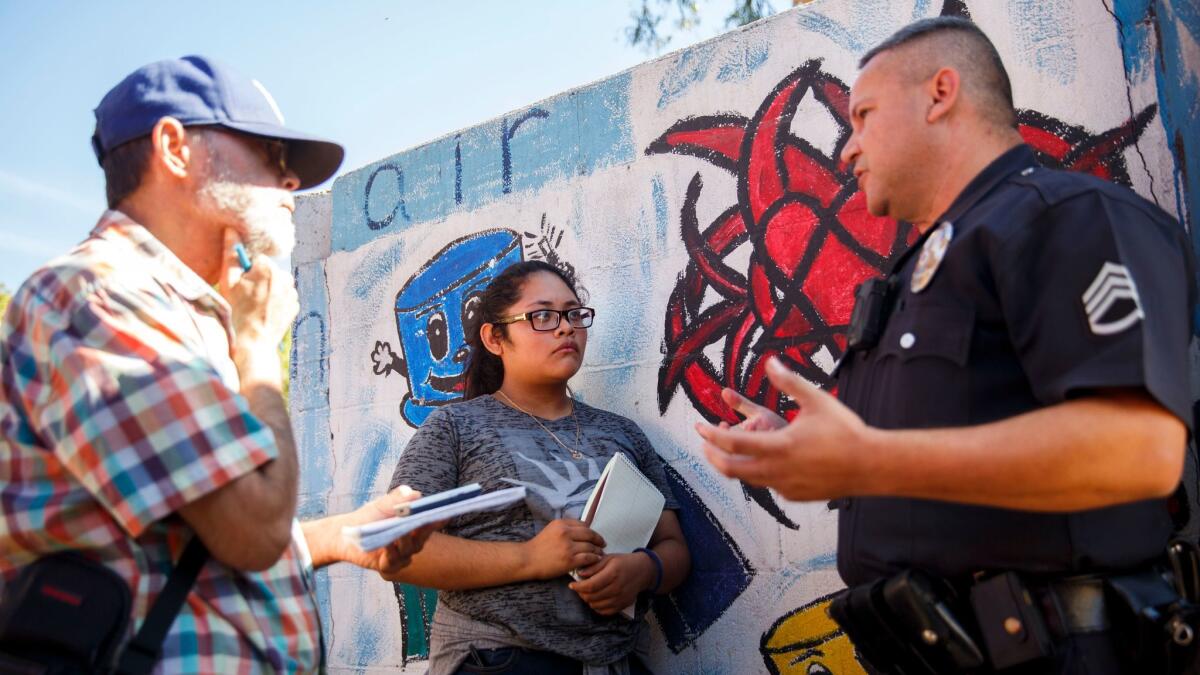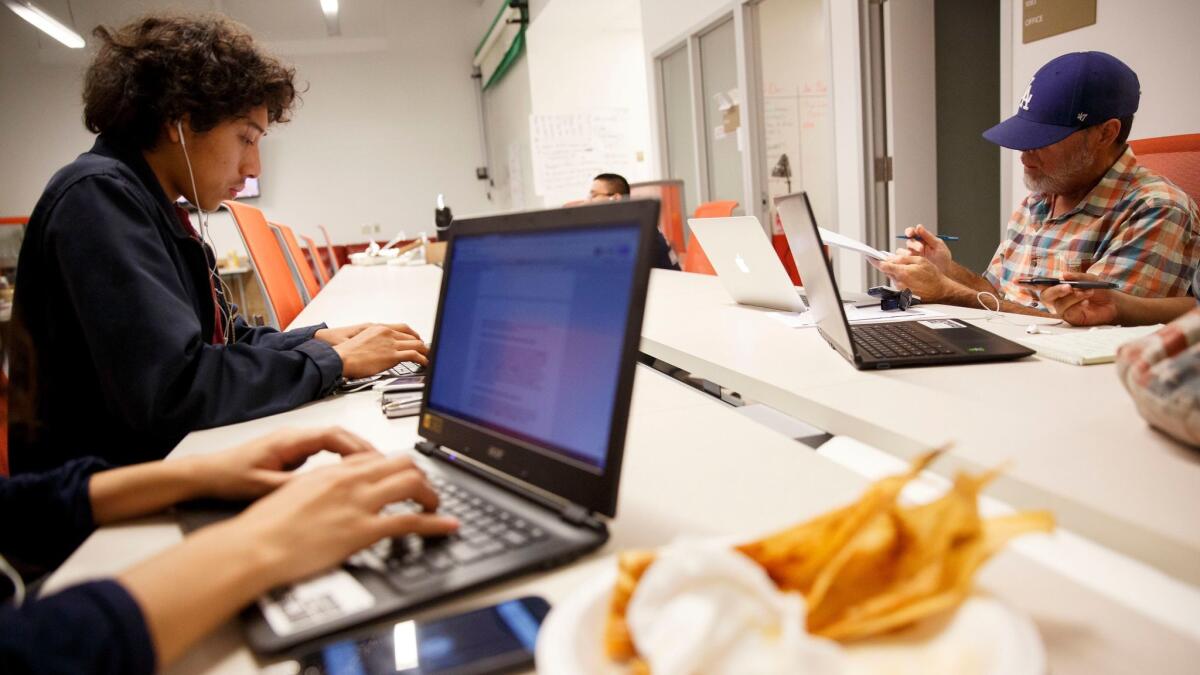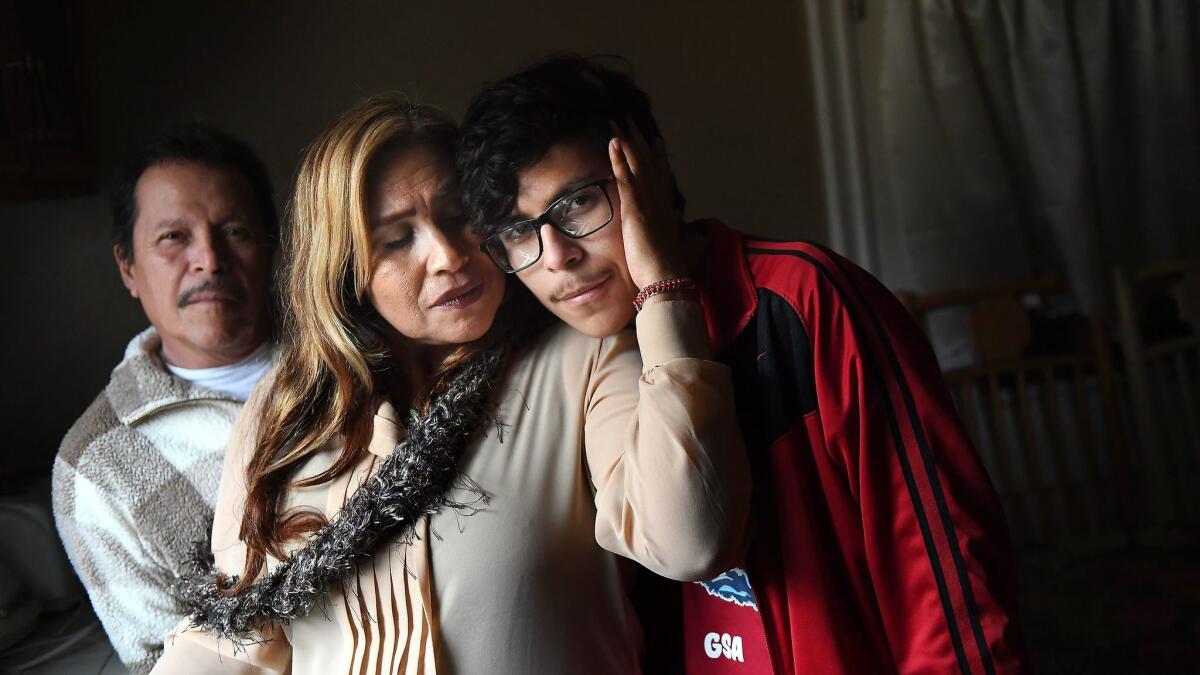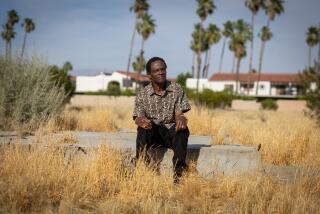How these high school reporters are covering Boyle Heights’ most pressing topics

Diego Flores went door to door.
But nobody, it seemed, wanted to speak to a journalist.
“Maybe I can leave my number for your manager and he can call me?” he asked one shopkeeper.
“What if I set up an appointment and return?” he asked another.
This was the first time the 16-year-old was out on the street reporting. He wasn’t going to let rejection get in the way of his deadline.
This school year, Flores joined the Boyle Heights Beat, a newspaper in which high school students write about the historic Latino neighborhood east of downtown. Their stories run in Spanish and English, online and in print.
It’s a small operation, run out of a donated space at an old hospital. But in the six years the Beat has been around, the paper has become a key voice for the community. The teenagers who run it have learned as much about themselves as they have about Boyle Heights.
“I’m a pretty confident person,” said Flores, who caught a ride after school with his dad so he could spend the afternoon reporting. “But this has really pushed me to do things I would have never done on my own.”
The students, who learn as they go, cover Boyle Heights’ most pressing topics, including gentrification, street vending and immigration. They’ve reported on elections, real estate disputes and police shootings. Many of their stories generate from ideas that begin with family and friends.

Jennifer Lopez at age 17 wrote a feature on Don Cheto, a man whom many in Boyle Heights, including her mother, count on to deliver packages to their native Puebla. Zola Cervantes, a junior who plans to go to college soon, wrote about Latino parents who have a hard time letting their kids move out. After he pushed through his own emotional struggle, 16-year-old Saul Soto reported on mental health issues.
“Our kids have a tremendous sense of responsibility to tell their stories,” said Co-editor and Publisher Michelle Levander. “This is a way to get to know a community in a very intimate way.”
Levander, who’s the director of the USC Annenberg Center for Health Journalism, launched the Beat back in 2010 with Pedro Rojas, former executive editor of La Opinion. They wanted to create a youth-driven paper with a local focus, and chose Boyle Heights because of its history, strong Chicano identity and challenges.
The newspaper gets by on an annual budget of about $230,000, with donations from organizations such as the California Endowment and the USC Good Neighbor Campaign. Four times a year, about 16 reporters and three editors put out a paper with a circulation of about 33,000 .
The goal, Levander said, is not to persuade students to become journalists (though some want to), but to teach them skills such as leadership, research and time management.
“They are not only getting professional journalism training,” said Los Angeles City Councilman Jose Huizar. “They are learning how to think critically in a way that will benefit them for the rest of their lives.”
To find story ideas, the teenagers host a quarterly community gathering. It’s a town-hall-style meeting, with pan dulce and cafe de olla, held at Boyle Heights City Hall.
On a recent weeknight, when a rainstorm pounded the city, nearly 100 people showed up to the first meeting of the year.
There were parents, activists, city workers, college students and health professionals. In the crowd were a farmers market vendor, a hairstylist and a teacher.
Liberty Gonzalez, a high school junior, ran the meeting. After reporters took turns describing the pieces they’d written in the Beat’s last edition, Gonzalez stepped in to address the audience:
“We’re here to ask you for story ideas,” she said. “We want to know, what would you like us to write about next?”
For nearly two hours, neighborhood people took turns at the mic.
An older man requested more follow-up on big stories. A healthcare worker wanted reporting on pregnant women and homelessness. A teacher asked reporters to pay close attention to how President Trump changes education.
“I don’t want guys smoking weed outside my house at night,” said Francisco Gallardo, who has lived in the neighborhood since 1979.
“I would really like to see a running club in Boyle Heights,” said Vanessa Perez, a new resident who didn’t know such a club already exists.
Gentrification, a growing concern for the neighborhood of 90,000, came up again and again.
New barber shop owner Lino Campos was among those concerned.
“People came into my business and called me a gentrifier to my face,” said Campos, “without even knowing that I’m from this community.”
The students, spread out across the room, listened intently, took notes and asked for phone numbers. Flores took photos to share online.
It was a busy night for teenagers who spend most of their days sitting in classrooms. Working at the paper, they’ve learned to handle their share of readers’ criticism. They’ve also come to understand the trust people put in them, and the responsibility that goes with it.
“Everywhere I go, I talk about you and I talk about this paper,” Daisy Chavez, the neighborhood council president, told them. “I’m proud of you.”
Candelaria Medina, in the back of the room, nodded in agreement.
Her son, Alex, a junior at Francisco Bravo Medical Magnet High School, joined the paper nearly two years ago.
At the end of junior high, he told her he was gay.
“OK, son,” she told him. “We’re going to walk with you always.”

At school, Alex remained quiet about his sexuality. Then a year ago, at age 15, he decided to write a story about Boyle Heights’ growing gay community.
”Writing that story helped me open up and feel more comfortable with who I am,” Alex said.
Through his reporting, he and his mom discovered several local LGBT organizations, and they got involved.
Now, wherever mother and son go, they speak up about gay rights and help other Latino parents learn to be more accepting of their gay children.
“Thanks to the newspaper, we found a community,” Medina said. “And we’ve educated ourselves so we can be out here, helping others.”
Twitter: @LATBermudez
More to Read
Sign up for Essential California
The most important California stories and recommendations in your inbox every morning.
You may occasionally receive promotional content from the Los Angeles Times.











